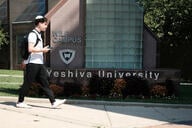You have /5 articles left.
Sign up for a free account or log in.
Seton Hall University's new core curriculum was seven years in the making, pegged to the 2001 creation of a "core curriculum" committee. But, like many a curricular redesign, Seton Hall's can be traced much further back. "This is something that had been tried on our campus many times before, and it’s been tried on many, many campuses across the country, many times unsuccessfully,” says Roseanne Mirabella, chair of the political science department and core curriculum committee co-chair at Seton Hall, a Roman Catholic university in New Jersey.
“We had the benefit of having these very well-intentioned but failed attempts before us."
Among the lessons they applied this time around: "We wouldn’t let anyone say, ‘Every educated person needs to know X,’ because the minute you get into ‘Every educated person needs to know X,' you get into discipline wars. Let’s talk about outcomes. What do we want our students to become? We wanted them to become caring, thinking individuals -- compassionate. Faculty said we want them to have the skills that they need to be successful, writing or communication. We went from there," Mirabella says.
Many people at Catholic colleges are concerned about their institutions maintaining strong religious identities as the proportion of active Catholics filling faculty and administrative positions has fallen. More broadly, colleges of all stripes have been drawn into a discussion of how best to tie the undergraduate education to a set of measurable learning outcomes. Against that backdrop, Seton Hall's two-pronged curricular reform may seem particularly relevant. Seton Hall is now implementing the new, university-wide core approved by the Faculty Senate in 2005. It entails the creation of common, interdisciplinary classes -- intended to connect to the institution’s Catholic mission -- and also the "infusion" of an explicit attention to various "proficiencies" in courses throughout the curriculum.
“I really felt that our students could benefit from this, could benefit from having a common core, a common experience, that helped them understand more what a liberal arts experience is all about,” explains Mirabella.
Seton Hall’s new core consists of 16 credits, including three, three-credit “signature courses"; College English 1 and 2; and a one-credit “University Life" class. The signature courses, unsurprisingly, are described as the hallmark of the new curriculum.
The first two, taken freshman and sophomore years, respectively, rely on an interdisciplinary “great books” approach, read with Catholicism as a lens. "The Journey of Transformation," taken freshman year, "seeks to forge a community of conversation inspired to explore perennial questions central but not exclusive to the Catholic intellectual tradition” (per the syllabus). Central texts on “transformative journeys” read and discussed in the class include the Bible (the Gospels, specifically), the Bhagavad Gita (a Hindu text), and Dante’s The Divine Comedy.
The second interdisciplinary signature course, Christianity and Culture in Dialogue, is somewhat more social science-oriented, drawing on readings from Karl Marx and Friedrich Nietzsche in addition to the writings of the Second Vatican Council. The third and final signature course, taken in a student's junior year, is intended to expand on the themes of the first two courses, but in a discipline-specific setting. Third-year core signature courses being tested out this year include a history class on Catholics and the social tradition and a nursing offering on the Christian intellectual tradition and contemporary health care.
This fall is the first time all Seton Hall freshmen are required to take the signature course sequence. Gabriel Esteban, the provost, is teaching one of 65 sections of “The Journey of Transformation” being offered this fall. As a former business school dean, says Esteban, “the readings were very different obviously from what I’m used to reading.”
“What this has done is it kind of creates a common experience for our students,” and for faculty as well, he says. “What I’ve really enjoyed is the spirit of helping each other” over regular faculty lunches and a listserv, Esteban says. “Not really to commiserate but share ideas, what’s working, what’s not.”
To compensate for the extra faculty effort -- those teaching the interdisciplinary signature courses have to master content "that quite frankly is outside their area of expertise,” as Mirabella says -- there are incentives. Seton Hall professors are eligible for $1,000 stipends for taking training to teach a signature course, and another $1,000 “bounty” the first time they teach it. Six new professors were hired this year, with another six hires scheduled for next.
A Parallel Focus on Skills
The second primary element of the core curriculum -- the infusion of “proficiencies” in courses akin to a “Writing Across the Curriculum” approach -- will be implemented next fall. Faculty are also eligible for stipends for completing training on infusing their courses with a focus on up to two of five proficiencies -- reading and writing, numeracy, critical thinking, oral communication and information fluency. Next fall, incoming freshmen will be required to take 10 infused courses while at Seton Hall (although the infused signature and freshman English courses will count toward that total). The number rises to 12 and 15 for subsequent classes.
"We're going to need hundreds [of infused courses] ultimately just to begin," says Mary Balkun, the English department chair and co-chair, with Mirabella, of the core curriculum committee.
“To be honest with you, I don’t really know [exactly] how many we need,” she says. “I want a student who wants to take a course with oral comm infusion to do it, in the semester she wants to do it, without too much of a hassle.”
“Ultimately what we’re hoping is we won’t hear what we unfortunately hear too often from students wherever they go to school -- well, ‘You know what, I didn’t write a paper after English my freshman year.' Or, 'I did an oral presentation my freshman year in oral comm. And never did again.' And then people wonder why they hire someone out of college who can’t write or can’t speak well,” says Balkun.
Hammering out draft guidelines for what a critical thinking-infused course looks like has been particularly tricky, and those guidelines are still in flux, Balkun said. But, speaking concretely, draft guidelines on how to infuse a course with numeracy, for example, stipulate that assignments should include significant readings or the use of resources “which require the student to verify computations, [and] explain why certain methodologies were used” -- among other requirements -- and that specific questions evaluating numeracy skills should be included on tests and exams.
Over all, the principle behind a proposed assessment structure for the new curriculum is a commitment to "embedding" assessment into the courses -- as opposed to administering generic and de-contextualized tests in critical thinking and other proficiencies. "So, for example, one of the things that we're experimenting with now," says Ed Jones, an associate professor of writing and chair of a committee charged with assessment of the core curriculum, "is we have a rubric we developed for evaluating reading and writing in the signature 1 course that came out of the goals that the professors themselves have decided upon for signature course 1. They're going to use that rubric in scoring the film critiques that the students are writing." The assessment committee's proposals are pending approval.
The implementation of the new core curriculum at Seton Hall is still very much in its early phases. The infusion of “literacies,” or discipline-specific skills, is still on the wish list but has been moved to the back burner, for instance.
And overlaying the core curriculum -- overlaying all of this -- each undergraduate college at Seton Hall also maintains a recently revised set of distribution requirements that its students must satisfy.
Mirabella, the core curriculum committee co-chair and a public administrator by training, is the “chart person" for this, she says, the person who outlines the “scores of things that must be done to get it done on time.”
Of the core, “I think it’s my life’s work now,” she says. “I enjoy it.”




